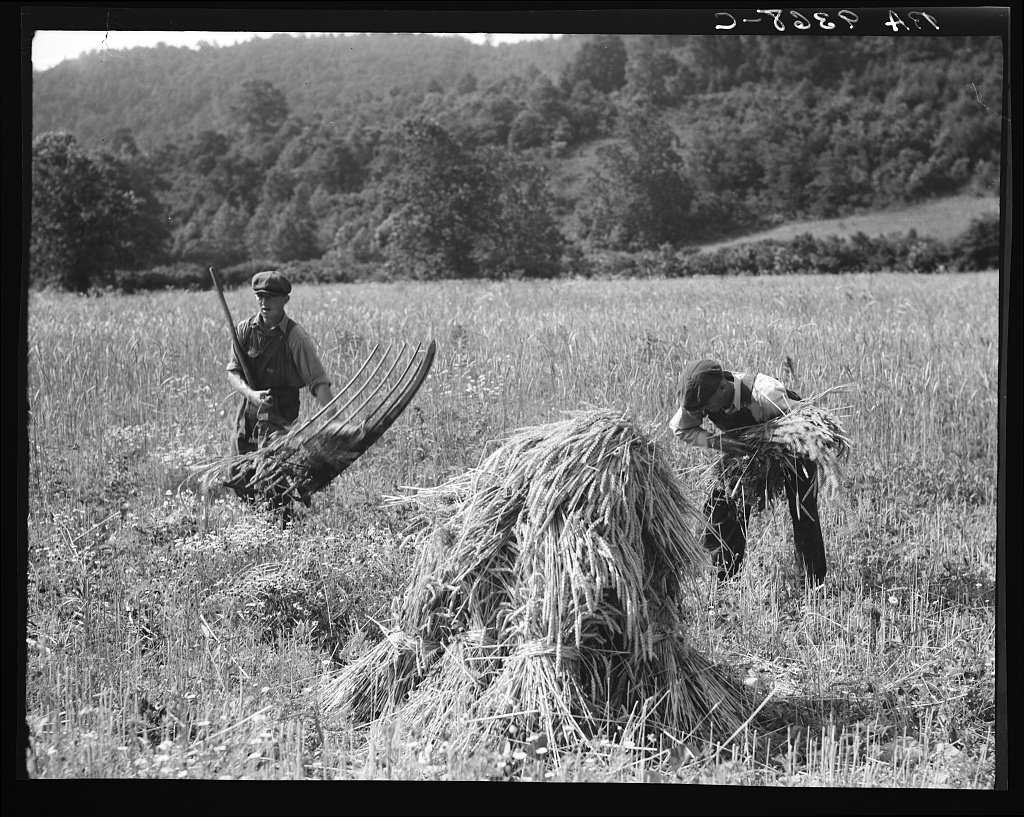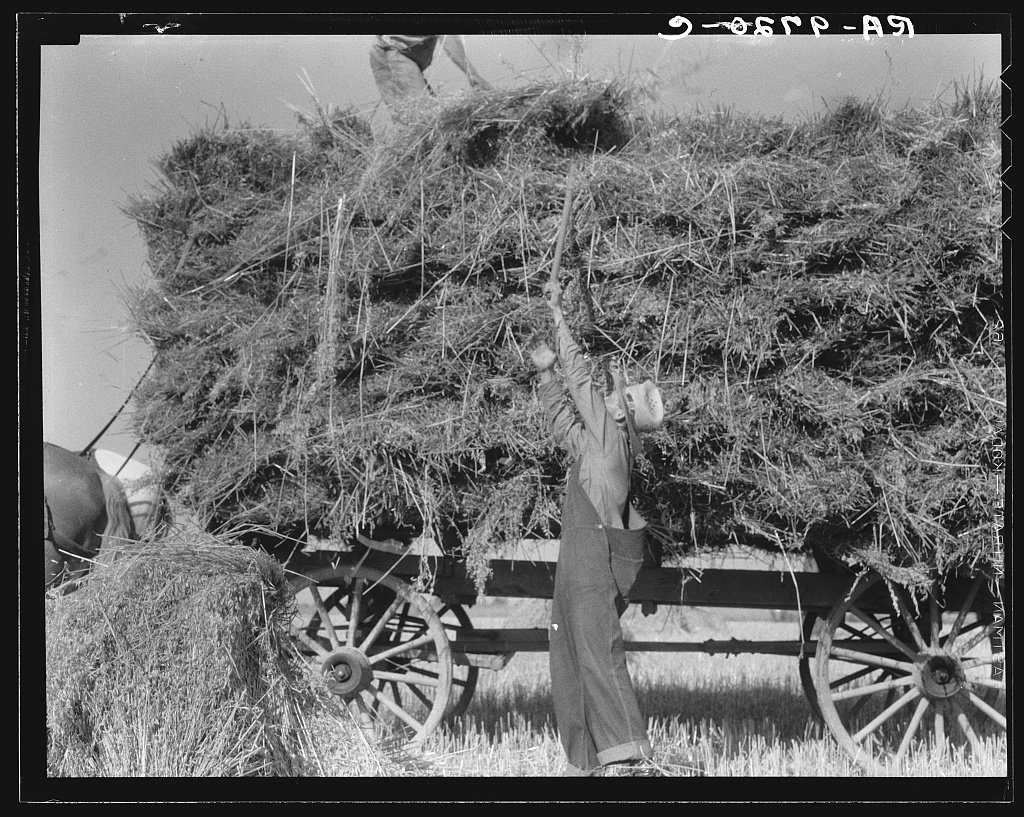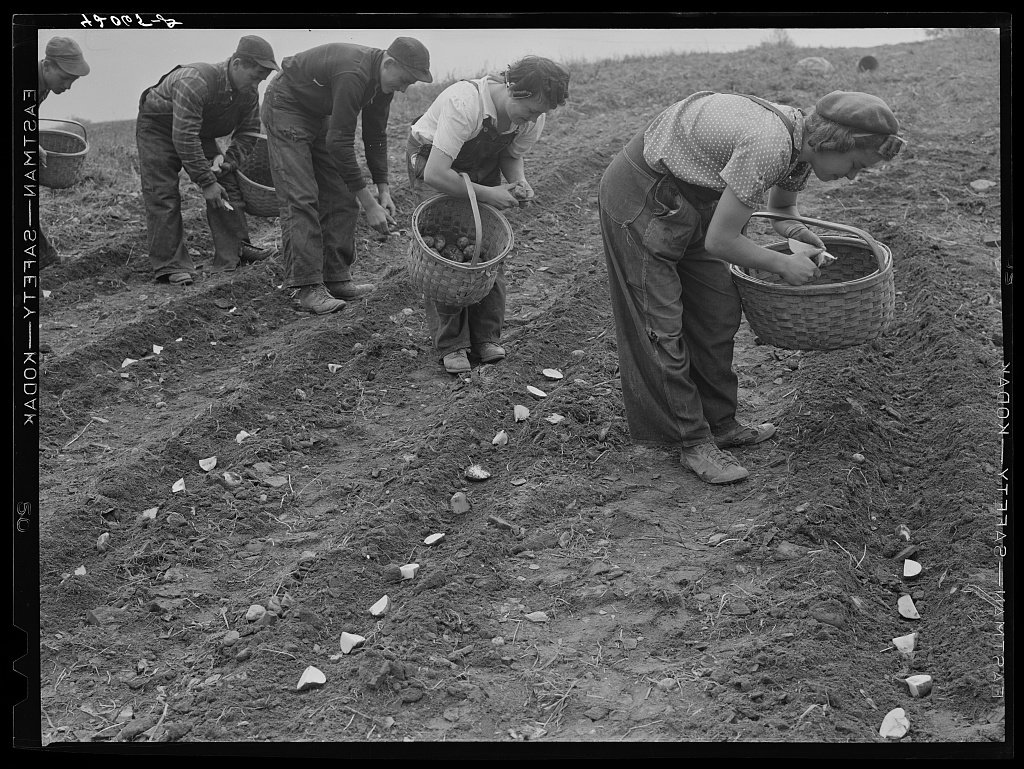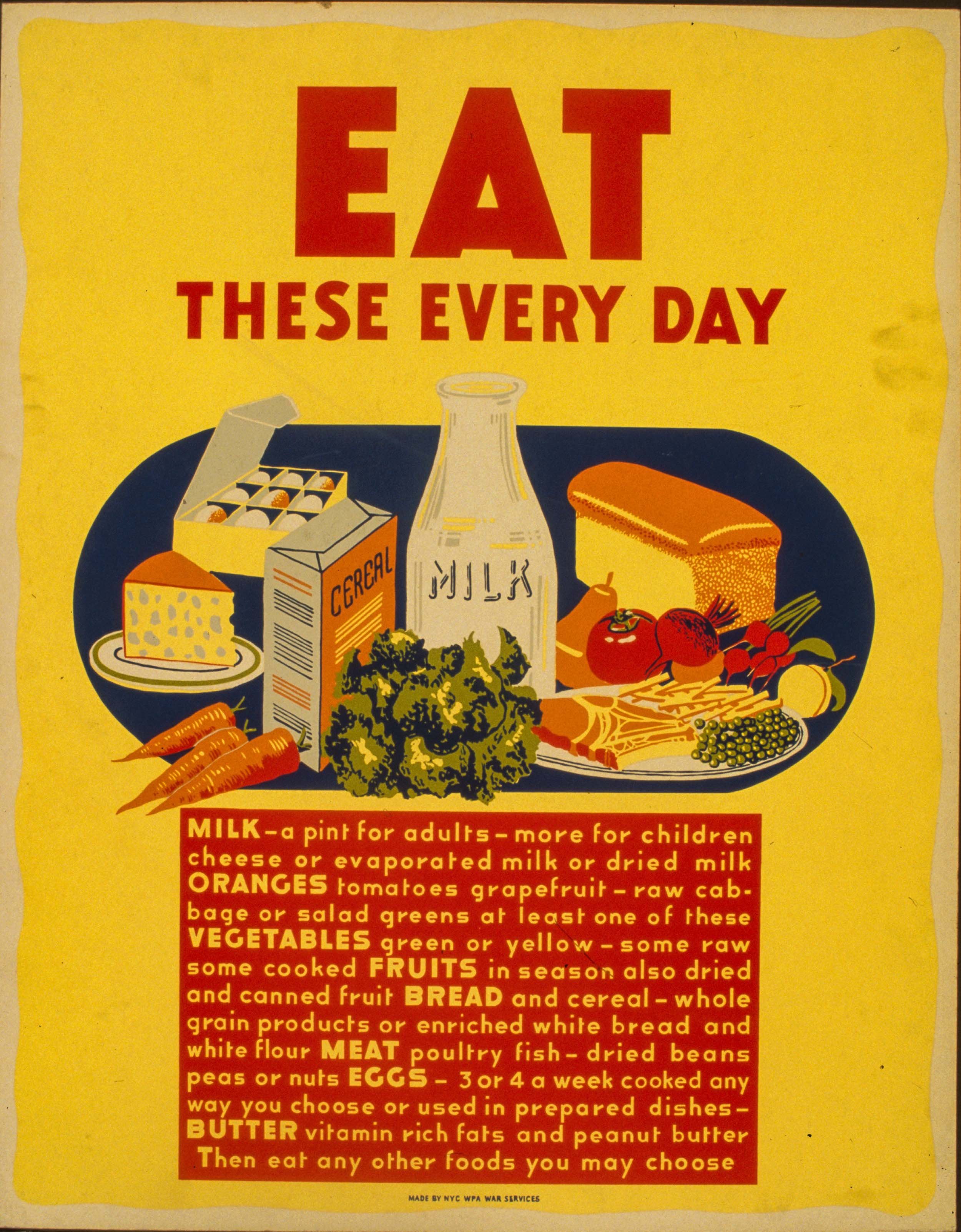A Civics Lesson

This year, Congress will debate, negotiate, and vote on a massive piece of legislation called the Farm Bill. Its policies will affect the local food you bring home to your kitchen.
Images from The Library of Congress Archives
I drove up to the Ohio Ecological Food and Farming Association (OEFFA) conference in Newark, OH, on an overcast February day. I thought the annual get-together would be a good place to get myself up to speed on the Farm Bill, that $400 billion-plus omnibus collection of federal legislation that is up for reauthorization and debate this year.
“People don’t realize how important it is,” OEFFA’s Heather Dean told me. “It shapes so many aspects of daily life, our landscapes, what we eat, who gets to farm.”
The drive itself was a good reminder of why the Farm Bill matters. Though I love the sense of space and big skies on the 100-mile stretch between Cincinnati and Columbus, there wasn’t much to see but brown, tilled fields. Even when I’ve driven this way in the lushness of summer, there seems to be something wrong. Most of the fields are planted in corn or soybeans, treated with herbicides and pesticides, stretching from the side of the road to the horizon, farmhouses dotted here and there like islands within a sea of crops coming up to their doorsteps.
The factory-style monoculture of few chemically dependent crops that is so evident in the rich soils of Ohio is the heart of any critique of the Farm Bill. Federal money started flowing to farmers during the Great Depression, to protect them from ruin and ensure the food supply. Ninety years later, support for agriculture is widely accepted as a legitimate use of federal money, but those Depression-era emergency payments have mostly become a subsidy to large farms that predominantly grow only a small designated number of commodity crops.
Ohio’s corn and soy are chief among them, but also wheat, rice, and cotton. (Dairy and sugar get their own support.) Because government support makes them reliably profitable, farmers plant them. Because there’s little downside to planting them, they plant them on every bit of land they’ve got. And because they’re cheap to buy, they are essential to food manufacturers. Corn, for example, is processed as food for animals or as a refined product such as high-fructose corn syrup used in processed food. One bushel of corn can sweeten 400 soft drinks, according to a corn industry website.
The Farm Bill, which is re-authorized roughly every five years (the 2018 Farm Bill expires in September), has evolved to support large over small, corporate over family, conventional over organic, and extractive over sustainable farming. It has given federal money to corporations that are already rich and encouraged consolidation in agriculture, which puts the food supply at risk. And it’s not really working to feed America.
SMALL FARMERS NEED A FAIR SHAKE
At the OEFFA conference, I found a group of people with a completely different relationship to farming than what I saw on my drive north. I met sheep farmers, organic farmers, and urban farmers. They sell at farmers’ markets, through CSAs, and via other local channels. Over a conference meal of locally sourced pork enchiladas and apple dumplings, I talked with people who have given their heart and soul to the kind of farming that could fix many problems we have. They manage their farms like complex ecosystems, sequester carbon, improve soil, grow healthy food, reduce food miles, and put dollars back in local economies. There were workshops on how to farm better: on cover crop strategies, holistic planned grazing, and biological control in beehives.
But these days, farmers are aware they have to keep one eye on Washington just as they keep one on the weather. Many workshops and discussions at the conference leaned toward big-picture policy questions or wonky details of legislation. No matter how much work farmers put in, they are fighting an uphill battle on a playing field that’s been slanted in favor of industrial agriculture.
Depression-era emergency payments have mostly become a subsidy to large farms that predominantly grow only a small designated number of commodity crops.
“The Farm Bill is about fairness,” Laurie White of the Kentucky Community Farm Alliance told me. “It’s the food that is always recommended for good health like fruit and vegetables, nuts, and whole grains that don’t get any kind of subsidy.” The federal government itself, through USDA guidelines, recommends fruits and vegetables over processed food. But the latter gets the government’s dollars.
So there was much discussion about how more of the flow of the mega dollars of the Farm Bill can be diverted from corporate operations to help small and medium farms that participate in local food systems. The policy discussions also went big and wide, looking at topics affecting all of national agriculture and urgent crises such as climate change, the depopulation of the countryside, the aging of farmers, and the need for equity, including racial equity, in access to land and resources.
IT’S BIG. IT’S COMPLICATED.
I came away a little overwhelmed: the Farm Bill is a monster. The acronyms for every section and program alone are enough to make a person give up on figuring it all out. And the obstacles to reforming it are daunting. From 1933 to now, there have been 18 versions of the Farm Bill, each with its own name. Policies have been added to, changed, changed back, rewritten. Provisions that made sense at one time have become solidified even when they were no longer relevant. Original intentions have been distorted by loopholes big enough to drive a John Deere harvester through.
I’m sure many activists would like to go straight to the heart and just cut out most of the commodity assistance and crop insurance programs, or make them available to every farmer. But that is a big ask. Commodity crops are entrenched in the food system and they keep food most Americans like to eat affordable. Plus, the subsidies are well defended by corporate agriculture, which protects its interests with high-powered lobbying: Agriculture spent $165 million on lobbying in 2022 (employing 1,241 lobbyists, 60% of whom are former government employees).
So local food and sustainability advocates are not asking for the very biggest things, but they’re asking for plenty. What are the policies that might affect the farmers you see at markets across the Ohio Valley, the locally grown, raised, made, or sourced products you bring home to your table? And what are the Farm Bill issues that touch other folks in our community?
Here are just a few of the positions local-food advocates are taking to address the 2023 Farm Bill as it passes through Senate and House Committees on Agriculture, Nutrition, and Forestry. This information comes mostly from the 144-page Farm Bill Platform of the National Sustainable Agriculture Coalition (NSAC), which has a large group of other organizations, including OEFFA, aligned with it.
Don’t cut SNAP
Many people don’t realize that the Supplemental Nutrition Assistance Program (SNAP), commonly known as food stamps, is part of the bill. In fact, SNAP is an overwhelmingly large part, because it is a means-tested program, also called an entitlement. SNAP spending is projected to be $1.43 trillion, or 85% of the entire bill. It is the biggest federal anti-hunger program, all of which combined serve 1 in 4 Americans. Sustainable farming advocates support keeping the program fully funded.
Put controls and caps on commodity subsidies
Speaking of entitlements, that’s what crop insurance and commodity programs have become. While anyone who wants to get SNAP benefits must prove they need them, (no more than $29,940 income for family of three) the same is not true of federal subsidies for farmers. The very richest farmers get the most money from the U.S. government. Not just the most money overall because they’re big, but the most money per acre. The American Enterprise Institute found that the largest 20% of farms get more than 75% of crop insurance payments, for instance. Pre-pandemic, $20 billion dollars in subsidies were going to farmers annually; those payments rose during the pandemic.
Title I of the Farm Bill (chapters are called ‘titles’), which covers commodity crops, includes programs to pay commodity farmers based on market conditions. The money goes to the farmer; married farmers get twice the payment. But children, siblings and grandparents, and cousins and nieces and nephews can also get the $125,000 payment. In 2020, a rule was reached by bipartisan consensus that anyone receiving that payment must provide 25% of a farm’s total management hours, or 500 hours annually. It was rescinded by President Trump. Small-farm advocates say it should be reinstated.
The bigger piece of commodity support is crop insurance. Farmers insure crops against both weather and price drops. They buy from a private insurer, but a federal program covers, on average, 60% of the premium. The policy pays when yields or revenues fall below guaranteed levels. Previously available only to commodity growers, the program recently expanded to cover 80 “specialty crops” like fruit and vegetables. It creates huge benefits for commodity farmers by removing risk, but also encourages wasteful practices. Advocates question whether rich farmers should be ineligible for the subsidy. An NSAC report projects the government could save $20.2 billion by capping payments for just 3% of the country’s largest farms. They also suggest capping subsidies at $50,000 for commodity crops and a higher limit for “specialty” crops (i.e., food production).
Adapt programs to work for smaller, diversified farms
While most farms of more than 500 acres have insurance policies backed by the federal government, very few under 260 acres are covered. Not because they don’t want to be, but because they’re not eligible. Insurance is for the crop, not the farm.
A program administered by the USDA, called Whole Farm Revenue Protection, tries to address these holes in the safety net by insuring entire farms. But many farmers have found it to be tightly wrapped in a lot of red tape. It’s hard to find insurers who understand it and will take the time to write a policy. So improving, strengthening, and marketing this program is a priority for reform via the 2023 Farm Bill.
In many other parts of the bill, programs—from research to technical assistance to conservation—are simply not designed for smaller, organic, or environmentally beneficial farms.
Strengthen local food systems
No matter how hard a farmer works, she can’t make money if there’s nowhere to sell her products. Local distribution channels have largely succumbed to consolidation, but the growing number of farmers’ markets contribute to Ohio’s economy: $80 million in 2017. In the Horticulture title of the bill, there are several programs meant to rebuild and support local and regional supply chains. For example, the Local Agriculture Market Program (LAMP) was introduced in the 2018 Farm Bill, co-sponsored by Ohio Senator Sherrod Brown. It supports farmers’ markets and provides grants for farmers to create value-added products (like packaged pickles, jams, or sauces). These popular programs are oversubscribed. Senator Brown has introduced a marker bill that makes them more accessible to smaller organizations. (A marker bill is written not to be voted on, but to attract discussion and support.) His bill includes increasing LAMP’s mandatory funding from $50 million to $75 million and rewriting provisions to make it easier to apply for grants.
Use agriculture policy to address climate change and other environmental crises
The Farm Bill includes programs under the Conservation title that pay farmers to use conservation practices. They can take wetlands out of production, buy energy-saving equipment, and improve soil. These programs are highly oversubscribed. But in 2022, through the Inflation Reduction Act, the Congress passed $20 billion in funding for climate-smart agriculture. It’s a crucial moment for comprehensive reform, and debates on how exactly to use that money will be part of passing the Bill. Will it benefit small and sustainable farms that already use conservation practices, or will it be a chance for big farms to enhance their bottom lines without significantly changing their practices? For instance, the USDA’s Environmental Quality Incentives Program (EQIP) is designed to encourage farmers and ranchers to integrate conservation into their acreage. Yet 50% of EQIP funding goes to big feed lots to build or maintain manure lagoons. So the question will be whether this new money will support farms employing the most impactful climate practices, not just the big farms. Food advocacy organizations say payment limits for conservation need to be written into the bill so that money is distributed among many farms.
Give minority farmers a leg up
NSAC suggestions begin with an acknowledgement that American farming is built on stolen land and labor. In 1910 there were 1 million Black farmers; today there are 45,000. Ninety-eight percent of agricultural land is now farmed by white people. There are still many barriers for socially disadvantaged farmers to acquire land and gain access to federal help. Almost every title of the bill offers opportunities to make the USDA more responsive to beginning and disadvantaged farmers with funding, new kinds of outreach, and technical support. The Native Farm Bill Coalition, for instance, would like to see that land that is farmed communally by a tribe is eligible for conservation grants. The USDA has created an Equity Commission to begin this work.
Widen access, streamline bureaucracy
Huge farms can afford the time needed to understand, apply for, and meet requirements for many federal programs. Smaller farms may find the process so onerous that they can’t manage it. Suggestions for the LAMP program include smaller percentages for dollars that farmers must put up to receive a grant, and easy-to-use grant proposals for the most common projects.
Make Your Voice Heard
Many policy fights loom, based on regional and partisan lines and where campaign contributions come from. Action groups like NASC, OEFFA, Union of Concerned Scientists, and others hope their campaigns will persuade legislators to use federal money for a kind of agriculture that will literally nourish America.
Just as important as these advocacy groups, though, are individuals who hope to, as NASC puts it, “build resilience and equity, restore competition, invest in science, and renew our environment for current and future generations.”
If that sounds important to you, organizations like OEFFA and NASC make it easy for non-farmer citizens to make their voices heard. Via their websites, you can sign up to write to or even meet with your senator or representative to express your priorities for this important and influential piece of legislation—a bill that affects what all of us eat, how it’s grown, and who gets access to healthy food.



![[Untitled] Corn, drought-stricken and eaten off by grasshoppers. Near Russelville, Arkansas. Dorothea Lange, 1936 Aug.](https://images.squarespace-cdn.com/content/v1/56d49b30c6fc08c53774434b/1692985355217-OTKOT9M4OBOLBGCADP9C/service-pnp-fsa-8b38000-8b38500-8b38531v.jpg)


In 1937, a few Depression-era federal relief programs coalesced to form the Farm Security Administration (FSA). Through the lens of its own documentary photographers, this government agency shared the plight of rural America with the public and lawmakers. The FSA is largely credited with helping tenant farmers purchase land and providing low-interest loans for new machinery (or more animals) to help make small-scale farming more efficient and financially viable for more rural families. The FSA was dissolved in 1946, and its lineage today is split among several agencies that support American agriculture—all with funding tied to the U.S. Farm Bill. (Image above: Destitute pea pickers in California. Mother of seven children. Age 32. Dorothea Lange, 1936 March.)
For More Info on the 2023 Farm Bill
Ohio Ecological Food & Farming Association
OEFFA’s online Farm Bill hub is a great tutorial on the issues that matter most to small and environmentally minded farmers in our region. You’ll find videos from farmers and ranchers about how the Farm Bill can affect them. And you can sign up to join OEFFA’s letter-writing campaign or to meet with your congressperson.
U.S. Department of Agriculture
Wondering what’s actually in the 2018 Farm Bill? Here’s where you’ll find the nuts and bolts.
National Sustainable Agriculture Coalition
NASC’s 2023 Farm Bill Platform is a great resource to understand the local-food issues relating to the bill; find it under the website’s Publications tab. The organization also has a helpful Advocacy Toolkit if you are moved to take action.
Food & Environmental Reporting Network
Search ‘Farm Bill’ on this website to read reporting from this nonprofit organization of independent journalists focused on food, agriculture, and the environment.
Food Research & Action Center’s Legislative Action Center
This nonprofit organization focuses on improving the health and wellbeing of people struggling with poverty-related hunger; its work related to the Farm Bill touches mainly on SNAP and other food assistance programs.
Civil Eats
This James Beard Award-winning nonprofit news organization features smart reporting on food and agriculture.
Polly Campbell wrote about restaurants and food and the development of the local food movement for The Cincinnati Enquirer from 1996-2019. She’s a u-pick fiend, a seasonal cook, and believes that money counts differently at farmers markets. A native of Bloomington, Indiana, she and her husband raised two daughters in Cincinnati. She was inducted in the Cincinnati Journalism Hall of Fame this year.





